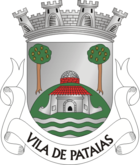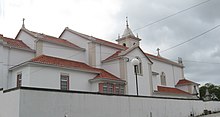Pataias
| Pataias | ||||||
|---|---|---|---|---|---|---|
|
||||||
| Basic data | ||||||
| Region : | Centro | |||||
| Sub-region : | Oeste | |||||
| District : | Leiria | |||||
| Concelho : | Alcobaça | |||||
| Coordinates : | 39 ° 40 ′ N , 9 ° 0 ′ W | |||||
| Residents: | 5437 (as of June 30, 2011) | |||||
| Surface: | 79.02 km² (as of January 1, 2010) | |||||
| Population density : | 69 inhabitants per km² | |||||
Pataias is a Portuguese city (Vila) in the Alcobaça district and Leiria district , in the historic province of Estremadura . It has an area of 79 km² and 5437 inhabitants (as of June 30, 2011). In 1984 she was given city rights again. It is located in the northern district, 18 km from Alcobaça. The municipality borders the Atlantic Ocean, from which the city is 6 km away. There Pataias meets the Nazaré district to the south . To the north, the city of Pataias meets the neighboring district of Marinha Grande , with which it is economically closely intertwined. Paredes da Vitória is located in the area of Pataias , a port town that was lost in the 16th century and was one of the thirteen towns of the Coutos de Alcobaça , the historical domain of the former abbey of Alcobaça . Pataias also belonged to this area until the state closure of the monasteries in Portugal in 1834.
history
Pataias and its forests are first mentioned in a document in the deed of donation from Afonso Henriques , the first king of Portugal, from 1153, with which the king gave the area between Leiria and Óbidos, which has just been freed from the Moors , to Bernhard von Clairvaux , the abbot of the Cistercian abbey Clairvaux in France to the extent of about 500 km² to found a monastery. At that time Pataias belonged to the port city of Paredes da Vitória, which probably already existed in Roman times. With the fall of this port city from the beginning of the 16th century, Pataias gained increasing importance as many residents of Paredes moved there. In 1542 the church was moved from Paredes to Pataias, with which the city of Paredes became extinct. In the same year Pataias was given city rights. The city grew rapidly. For the Abbey of Alcobaça it gained great importance in the production of lime and cement, which is still evident today from numerous remains, including historical lime kilns ( Fornos de Cal ). The parish church of Pataias dates back to the relocation of the medieval church of Paredes, which also made it a place of worship for the patron saint of Paredes, Nossa Senhora da Vitória , although the object of this worship, a statue of the Madonna, came to Famalicão (Nazaré) , where former residents of Paredes also settled. She is remembered in an annual procession from Pataias to today's village of Paredes on August 15th.
economy
Pataias is a modern industrial and commercial city. Just as it gained early industrial importance for the Alcobaça Abbey, the modern economy is also shaped by the extraction of building materials from stone and earth, but also by wood processing. In addition, a modern plastics and metal processing industry has emerged. In addition, as in the neighboring district of Marinha Grande, the ceramic and glass industries are strongly represented. Tourism is developing in the coastal region, mainly through holiday apartments. The location is supported by a rail and a motorway connection.
landscape
Pataias is located in the middle of the Pinhal de Leiria , the pine forest of Leiria, which King Dinis (1261-1325) had already created in the entire coastal area of the area to fortify the shifting dunes. To the west of Pataias lies a heavily swamped lagoon surrounded by a pine forest. The forest stretches towards the sea, where Pataias has several extensive sandy beaches. Wide, separately laid out cycling and hiking trails lead from the city to the stands 6 to 8 km away, some of which are surrounded by dunes.
literature
- Maria Zulmira Albuquerque Furtado Marques: Por Terras dos Antigos Coutos de Alcobaça , Alcobaça 1994, pp. 165-175
- António Maduro: Os Fornos de Cal de Patais , in: Roteiro Cultural da Região de Alcobaça , Alcobaça 2001, ISBN 972-98064-3-8 , pages 166-185
Individual evidence
- ↑ www.ine.pt - indicator resident population by place of residence and sex; Decennial in the database of the Instituto Nacional de Estatística
- ↑ Overview of code assignments from Freguesias on epp.eurostat.ec.europa.eu
Web links
- Map of the Freguesia Pataias at the Instituto Geográfico do Exército



